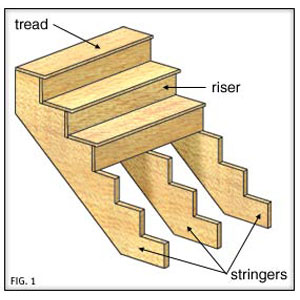 A few years later, my dad was planning to call a carpenter to replaced the rotting front steps to the house. During a weekend when my parents went away, I took the old stairs apart, examined how they were constructed, purchased the materials and rebuilt the front steps. When I was in the military, I learned how to break down my weapon, clean it, and put it back together again with my eyes blindfolded. This was a life and death kind of application. After my first year of teaching in 1974, when I apparently made every mistake a first year teacher could make and even created some new ones, so my supervisor informed me, I used the notes and lessons from that first year to begin construction of the next year.
A few years later, my dad was planning to call a carpenter to replaced the rotting front steps to the house. During a weekend when my parents went away, I took the old stairs apart, examined how they were constructed, purchased the materials and rebuilt the front steps. When I was in the military, I learned how to break down my weapon, clean it, and put it back together again with my eyes blindfolded. This was a life and death kind of application. After my first year of teaching in 1974, when I apparently made every mistake a first year teacher could make and even created some new ones, so my supervisor informed me, I used the notes and lessons from that first year to begin construction of the next year. Eventually, after a number of years of teaching I was introduced to a concept called Backward Design. I loved it, it was a piece of cake to me and something a I had been doing all of my life. What this new idea did for me was to confirm my instincts as a teacher. Backward Design (BD) is a simple approach to curriculum design, to teaching, and to pedagogy. BD is a three step process. We are once again using it in my current school.
Eventually, after a number of years of teaching I was introduced to a concept called Backward Design. I loved it, it was a piece of cake to me and something a I had been doing all of my life. What this new idea did for me was to confirm my instincts as a teacher. Backward Design (BD) is a simple approach to curriculum design, to teaching, and to pedagogy. BD is a three step process. We are once again using it in my current school.Step one asks that we consider what the goals of the class will be. We must determine what we want the scholars to learn and to understand at the end of the course. We determine what expectations we want of the scholars. We need to ask provocative questions in this step so as to tease out the essential goals of the course. We list the skills and knowledge criteria we need to have absorbed by all by the end of the course. We must consider summative assessment tools at this point.
Step two asks that we address how we plan on understanding how the scholars learn. We need to create formative assessment tools like quizzes and conferences to help us determine what is being learned, how it is being learned and if it is being learned by the scholars. We need to ascertain what data will be collected that demonstrates scholarly learning in the class. Data collection is crucial and ongoing.
Step three is the most extensive step as here we plan projects and daily lesson plans. Now that we know the goals and how we will assess, we need to select the material we will teach in our class to reach our goal.

CyberEnglish was designed as I have said during my college days. Maybe it was conceived when I was deconstructing that bicycle as a ten year old. And all through my life I had different "epiphanies" and experiences that helped shape what happened in 1993 when I actually taught a course called CyberEnglish. It was and is built on the Backward Design concept. even as I speak to other teachers who have a variation of CyberEnglish, Backward Design is a crucial part of the development. The final product for each scholar is hir webfolio. Similar to a portfolio, except it includes all of hir work. The final month of the year is spent reviewing the work, commenting on the process of doing the work, engaging in peer review, and so much more. Webfolios are living documents in that since they are public, the scholars are always receiving email about their work.
One of the advantages I have found with CyberEnglish from the early years of my career, is that I find myself adapting more quickly. During a class, I may find some aspect of the course good or bad and want to tweak or change something. I do that now, not later. The result is that the next class gets the change and I can immediately study the affect of the change and thereby adjust my own pedagogy on the fly, instantly, in a nanosecond. I understand how each of us is in a different stage of Backward Design and because of CyberEnglish I find I am approaching Instantaneous Design.








0 comments:
Post a Comment